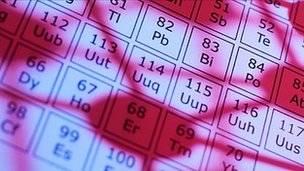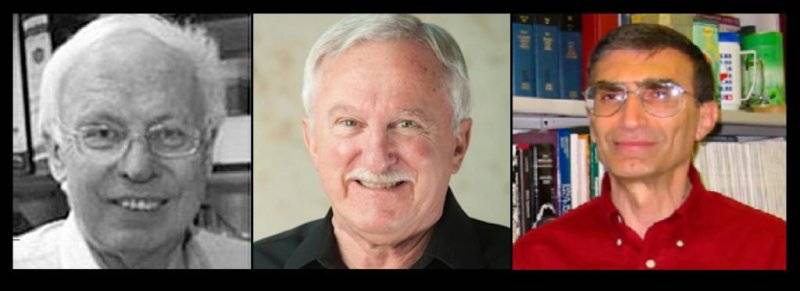I know J Stone will like this.
Israeli Scientist Wins Nobel Prize for Chemistry

http://www.nytimes.com/2011/10/06/science/06nobel.html?_r=1&hp
Israeli Scientist Wins Nobel Prize for Chemistry

An Israeli scientist won this years Nobel Prize in Chemistry for discovering quasicrystals, a material in which atoms were packed together in a well-defined pattern that never repeats.
Recent Nobel prizes have generally split credit for scientific advances among two or three people, but this years chemistry prize and accompanying 10 million Swedish kronor ($1.4 million) went to a single scientist: Dan Shechtman, 70, a professor of materials science at Technion-Israel Institute of Technology in Haifa. Dr. Shechtman is also a professor at Iowa State University and a researcher at the United States Department of Energys Ames Laboratory.
The citation from the Royal Swedish Academy of Sciences states simply, for the discovery of quasicrystals.
Such regular but nonrepeating patterns, defined by precise rules, have been known in mathematics since antiquity, and medieval Islamic artists made decorative, nonrepeating tile mosaics, but the phenomenon was thought impossible in the packing of atoms.
Yet Dr. Shechtman discovered the same type of structure in a mix of aluminum and manganese. During a sabbatical in Maryland at the National Bureau of Standards, now known as the National Institute of Standards and Technology, he took a molten glob of the metals and chilled it rapidly. The expectation was that the atoms would have been a random jumble, like glass. Yet when he examined his metal with an electron microscope, Dr. Shechtman found that the atoms were not random.
His notebook recorded the exact date: April 8, 1982.
Scientists believed that crystals in materials all contained repeating patterns. For example, a square lattice has fourfold symmetry. Rotate it by 90 degrees, and it looks identical. A repeating lattice with fivefold symmetry, however, is impossible. On that morning in 1982, the electrons Dr. Shechtman bounced off his aluminum-manganese alloy formed a pattern that indicated tenfold symmetry. Dr. Shechtman himself could not quite believe it. He wrote in his notebook, 10 Fold???
While a periodic lattice could not produce that pattern, a quasicrystal could.
It took years for Dr. Shechtman to persuade others.
During the announcement, the Nobel committee noted that one colleague initially said, Go away, Danny, because he thought there was a simpler explanation for what Dr. Shechtman had observed. Many scientists notably Linus Pauling, the Nobel-winning giant of chemistry argued vehemently that Dr. Shechtmans data could be explained by twinning, where two ordinary periodic crystals are fused together at an angle.
That must have been intimidating, said Nancy B. Jackson, president of the American Chemical Society. When he first discovered these materials, nobody thought they could exist. It was one of these great scientific stories that his fellow scientists thought was impossible, but through time, people came to realize he was right.
Even the definition of crystal had to be changed. Previously, a crystal had been defined as having a regularly ordered, repeating three-dimensional pattern, according to the International Union of Crystallography. The new definition, adopted in 1992, states that a crystal is simply a solid with a discrete diffraction diagram that is, something that produces patterns like the ones Dr. Shechtman saw.
That leaves the door open for yet more different kinds of crystals in the future. Quasicrystals have since been found in many other materials, including a naturally occurring mineral from a Russian river. Materials scientists have been exploring quasicrystals because of their distinct properties they are hard, brittle, slippery, and, unlike most metals, poor conductors of electricity.
Quasicrystals have so far had modest impact in the everyday world. For example, one kind of highly resilient steel, consisting of hard steel quasicrystals embedded within softer steel, is now used in razor blades and thin needles for eye surgery.
The applications havent panned out, said Patricia A. Thiel, a colleague of Dr. Shechtman at Iowa State and Ames Laboratory who also studies quasicrystals. But they revolutionized our understanding of how atoms arrange themselves in solids. It was a scientific revolution.
Israeli leaders expressed delight and pride at the 10th Nobel Prize won by their country, which has a population of less than 8 million. Two years ago, Ada E. Yonath of the Weizmann Institute of Science in Rehovot shared the award for chemistry as well.
Shimon Peres, Israels president, spoke by telephone to Mr. Shechtman at a news conference in Haifa and said, Professor Shechtman, you today brought an enormous gift to the State of Israel, truly. Prime Minister Benjamin Netanyahu also called and told him, Every Israeli is happy today, and every Jew in the world is proud.
Dr. Shechtman was born and educated in Israel. At the news conference, he said, The celebration is not only for the Technion and the State of Israel but also for science worldwide. There are today thousands of scientists around the world working in this field that I developed, and I am certain they all see this prize as their accomplishment and they really deserve it. Without these thousands, this science would not be where it is today.
http://www.nytimes.com/2011/10/06/science/06nobel.html?_r=1&hp



